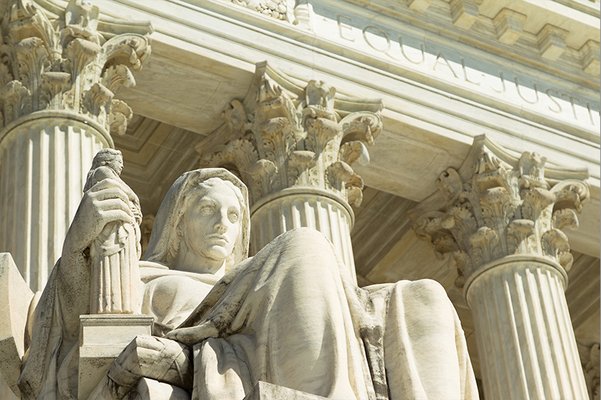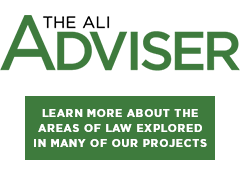U.S. Supreme Court Cites Model Penal Code

In Fischer v. United States, No. 23-5572 (June 28, 2024), the U.S. Supreme Court, in a concurring opinion, cited Model Penal Code § 242.1, which proposes a sweeping, all-purpose obstruction statute, in noting that Congress had never passed a similarly broad obstruction law and that there was no indication that Congress intended to do so under the Sarbanes-Oxley Act, 18 U.S.C. § 1512.
The Sarbanes-Oxley Act imposes criminal liability on anyone who corruptly “alters, destroys, mutilates, or conceals a record, document, or other object, or attempts to do so, with the intent to impair the object’s integrity or availability for use in an official proceeding.” 18 U.S.C. § 1512(c)(1). The next subsection extends that prohibition to anyone who “otherwise obstructs, influences, or impedes any official proceeding, or attempts to do so.” 18 U.S.C. § 1512(c)(2).
In this case, the defendant, a former county police officer from Pennsylvania, was criminally prosecuted for his conduct on January 6, 2021. On that day, both Houses of Congress convened in joint session to certify the electoral votes in the 2020 presidential election while a crowd of supporters of then-President Donald Trump gathered outside the Capitol. Eventually some of the crowd, including the defendant, “forced entry” into the building by breaking windows and assaulting members of the U.S. Capitol police, which led the Houses to evacuate the Chambers and delayed the certification process. Body-camera footage from that day showed the defendant “near a scrum between the crowd and police who were trying to eject trespassers from the building.” A grand jury returned a seven-count superseding indictment against the defendant for, among other things, violating 18 U.S.C. § 1512(c)(2) for his role in attempting to corruptly obstruct the congressional proceedings.
The defendant moved to dismiss, arguing that § 1512(c)(2) criminalized only attempts to impair the availability or integrity of evidence, because it was limited by the criminal violations enumerated in § 1512(c)(1). The district court granted the motion in relevant part, concluding that the scope of § 1512(c)(2) required the defendant to “have taken some action with respect to a document, record, or other object.” A divided panel of the D.C. Circuit reversed and remanded for further proceedings, finding that the word “otherwise” in § 1512(c)(2) meant that the provision unambiguously covers “all forms of corrupt obstruction of an official proceeding, other than the conduct that is already covered by § 1512(c)(1).” This Court granted certiorari.
Chief Justice John G. Roberts, Jr., delivering the opinion of the Court, vacated the judgment of the D.C. Circuit and remanded for further proceedings, holding that, to prove a violation of § 1512(c)(2), the government had to establish that the defendant impaired the availability or integrity for use in an official proceeding of records, documents, objects, or other things used in an official proceeding, or attempted to do so. The Court noted that the “otherwise” provision of § 1512(c)(2) was limited by the preceding list of criminal violations enumerated in § 1512(c)(1), which provided specific examples of prohibited actions “undertaken with the intent to impair an object’s integrity or availability for use in an official proceeding.” The Court reasoned that it made sense to read § 1512(c)(2) as limited by § 1512(c)(1), given that it was enacted by Congress to plug a loophole in the Sarbanes-Oxley Act uncovered by the Enron accounting scandal.
Prior to § 1512(c)’s enactment, the Court explained, the statute failed to “impos[e] liability on a person who destroy[ed] records himself.” The Court reasoned that it “would be peculiar to conclude that in closing the Enron gap, Congress actually hid away in the second part of the third subsection of Section 1512 a catchall provision that reach[ed] far beyond the document shredding and similar scenarios that prompted the legislation in the first place.” The Court maintained that “subsection (c)(2) was designed by Congress to capture other forms of evidence and other means of impairing its integrity or availability beyond those Congress specified in (c)(1),” noting that nothing in the text or statutory history of § 1512 suggested that subsection (c)(2) was designed to impose up to 20 years’ imprisonment on all defendants who committed obstruction of justice in any way and who might be subject to lesser penalties under more specific obstruction statutes.
Associate Justice Ketanji Brown Jackson, in a concurring opinion, agreed that § 1512(c)(2) did not reach “all forms of obstructive conduct” and was, instead “limited by the preceding list of criminal violations in § 1512(c)(1),” noting that she wrote separately to explain why and how the Court’s interpretation of § 1512(c) followed the legislative purpose of the statute. Justice Jackson noted that the Court’s goal in interpreting any statute should be “to give effect to the intent of Congress.” She reasoned that Congress had never enacted a “one-size-fits-all solution to obstruction of justice,” like the one proposed by Model Penal Code § 242.1 and enacted by many states, noting that nearly all of the “broad, all-purpose obstruction statues” that various states had enacted were classified as misdemeanors and were generally punishable by up to a year of incarceration. The concurring opinion noted that the Model Penal Code’s broad residual offense provided “a hedge against the ingenuity of offenders,” given that not all forms of obstruction could be anticipated and proscribed in specific offenses.
Justice Jackson maintained that it “beggar[ed] belief that Congress would have inserted a breathtakingly broad, first-of-its-kind criminal obstruction statute (accompanied by a substantial 20-year maximum penalty) in the midst of a significant more granular series of obstruction prohibitions without clarifying its intent to do so,” given that § 1512(c)(2) was a felony and imposed one of the more severe potential punishments in Chapter 73 of the U.S. Code. The concurring opinion agreed with vacating the judgment below and remanding the case for further proceedings to determine if the defendant’s conduct “involved the impairment (or attempted impairment) of the availability or integrity of things used during the January 6 proceeding ‘in ways other than those specified in (c)(1),’” to proceed with prosecuting the defendant for a violation of § 1512(c)(2).
Read the full opinion here.
